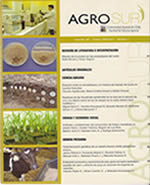CHARACTERIZATION OF CHILEAN PATAGONIAN CREOLE CATTLE. A CASE STUDY
Main Article Content
Abstract
Animal genetic resources are valuable in many aspects and they represent a unique heritage for the country. Chile has a great wealth of native, endemic, exotic and creole animal genetic resources, which generates high genetic diversity. In the Aysen region, there is an animal genetic resource called Creole Patagonian Bovine (BCP) that can be used to achieve improvements in the cattle-raising sector, however, the existing information of this breed at country level is very scarce regarding its characteristics and the current number of animals in the region.
The aim of this study was to phenotypically characterize the Patagonian Creole Cattle; the specific objective was to compare the Chilean Creole cattle with the Argentine Creole Cattle.
The study was conducted at a farm located 7 km from the city of Mañihuales in the Aysen region. The farm had 43 animals with over 50% of BCP genotype, which were evaluated for phenotypic characterization, productivity and reproductive health.
Bibliographical research was carried out on Argentinian Creole Cattle, to compare them with the Chilean Creole Cattle.
Morphological characterization studies showed that there was a sexual dimorphism in animals under study, with females presenting minor morphological measures. The hair of the bovines has a brown color base in most of them. Their reproductive and productive characterization reported a good fertility, calving ease, longevity and hardiness.
When comparing the Chilean Creole with its Argentinian counterpart, similarities were found in productive and reproductive aspects. Females are morphologically similar, and measure comparisons performed between males were not conclusive due to the reduced number of Chilean BCP males.

